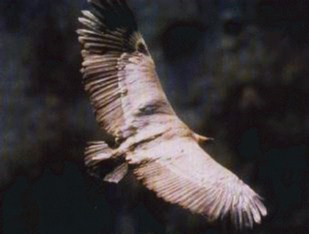|
 Cyprus is on a north-south migration route and there are many birds in
transit, some in vast flocks, some in small clusters. Cyprus is on a north-south migration route and there are many birds in
transit, some in vast flocks, some in small clusters.
These migrating birds
may only rest for a few days to a week. March to May is the period of northward migration and August to October the southward.
- Griffon Vulture: Kizil Akbaba (T); Gyps fulvus (L)
Status: Winter visitor; resident breeder.
- Hirundelle: Kir Kirlangici (T); Hirundo rustica (L)
Status: Migrant breeder.
- Golden Oriole: Sari Asma / Incir Kusu (T); Oriolus oriolus (L)
Status: Winter visitor, passage migrant.
- Pochard: Elmabas Ordek / Bozdalagan (T); Aythya ferina (L)
Status: Migrant breeder.
- Cyprus Pied Wheatear: Kibris Kuyrukkakani (T)
Status: Migrant breeder (Endemic); the most distinctive
and interesting species of all the endemic birds in Cyprus
- The Endemic
Butterflies of Cyprus.
The list of resident birds has few surprises for those familiar with the
general stock of European birds. The Griffon vulture is the largest and the
most distinctive in flight sue to its 8 ft wing-span which sometimes en-
courages a mistaken identification as an eagle, but there are no eagles now
in Cyprus. It can be spotted throughout the island but especially at the
eastern edge of the Kyrenia Range, between St. Hilarion and Kantara.
 Smaller resident raptors include the Scops and Little owl. Game birds are
represented by the Francolin, similar to the English partridge, and the
Chikor which is similar to the French partridge. They can both be seen
throughout the island, but especially in the Kantara area and Karpas
peninsula.
Smaller resident raptors include the Scops and Little owl. Game birds are
represented by the Francolin, similar to the English partridge, and the
Chikor which is similar to the French partridge. They can both be seen
throughout the island, but especially in the Kantara area and Karpas
peninsula.
On the coast you will see the lesser black-backed gull, the
herring gull and Audoins gull as well as the common cormorant or shag.
The black-headed gull is a winter visitor only.
There are several resident warblers and tits, and the island boasts an
indigenous species, the Cyprus warbler, found only here in scrub and open
woodland. It resembles the more widespread Sardinian warbler but without
the red eye and with very strongly marked black and white underpants.
The most spctacular winter visitors is the flamingo which inhabits in the
salt lakes, in South Cyprus, sometimes between October and March. The
arrival depends on the lakes water levels and a sufficient food source. A
lack of rain may delay their arrival to January. Many types of duck -shelduck,
mallard, teal, wigeon, pintails and shovellers- also visit the salt lakes,
dams and coasts in winter.
 The most beautiful summer visitors, between April
and September, are small colourful bee-eaters, the larger pale-blue roller,
the yellow and black golden oriole, and the unmistakable hoope of pink
plumage and black and white barred wings, body and tail. The most beautiful summer visitors, between April
and September, are small colourful bee-eaters, the larger pale-blue roller,
the yellow and black golden oriole, and the unmistakable hoope of pink
plumage and black and white barred wings, body and tail.
|
|
- Flint, P.,
& Stewart, P., (1992), "The Birds of Cyprus",
2nd edition, British Ornithologists Union, Henry Ling Ltd.,
Dorset Press, Dorchester, Dorset, England.
|









